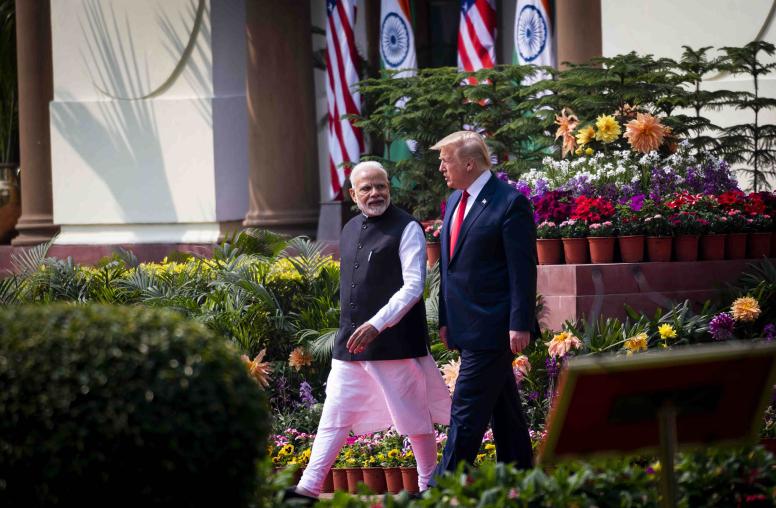Combating Religious Discrimination in India and Beyond
As India’s new citizenship law escalates religious tensions, a new USIP project seeks a comprehensive solution.
Last month, the U.S. Commission on International Religious Freedom listed India as a “country of particular concern” for the first time since 2004. The decision reflects increased religious hostility and sectarian conflict in India, which have been stoked further by the Citizenship Amendment Act (CAA) passed last December. In the five months since, the CAA’s use of religious identity as a criteria for citizenship has sparked widespread opposition and protest both within India and abroad. But while controversial, it is far from an isolated policy. It connects to a steady increase in religious discrimination and violence within India, throughout South Asia, and across the globe—raising important questions for policymakers and activists alike.

This rise in religious discrimination is not only noteworthy in its scale, but also its consequences. In many settings, increased government regulation of religion preceded an increase in political instability and conflict. Now, with the CAA sparking religious violence in one of the world’s largest countries, it is vital for peacebuilding practitioners to develop new ways of integrating religious freedom into broader strategies for development, democratization, and peacebuilding.
To that end, USIP has established a project called “Closing the Gap: Analyzing the Relationship Between Religious Freedom and Political and Economic Development.” In partnership with USAID’s Center for Faith and Opportunity Initiatives, the study will examine the CAA and other pressing issues related to international religious freedom.
The CAA, Hindu Nationalism, and Growing Religious Tensions in India
As a matter of policy, the CAA provides expedited Indian citizenship to migrants from Afghanistan, Bangladesh, and Pakistan that belong to select religious minorities and entered the country without a valid visa or overstayed their visa prior to December 2014. Absent from the list are Muslims and religious minorities from other parts of South Asia, such as Tibet, Sri Lanka, and Myanmar.
India’s ruling Bharatiya Janata Party (BJP) has long drawn on Hindu nationalism to consolidate their power. Critics of the CAA claim the law is another piece of the BJP’s Hindu nationalist agenda and will undermine India’s secular foundations and further marginalize and disenfranchise the country’s sizeable Muslim population, as well as other religious minorities.
The Indian government, however, maintains that the CAA gives millions of illegal migrants, who were vulnerable to detention and deportation, an accelerated path toward citizenship. They also defend the exclusion of Muslims by saying they are unlikely to face religious persecution in neighboring countries like Pakistan, where Islam is the official state religion.
Despite the Indian government’s explanations, the CAA has evoked impassioned dissent, as thousands of Indian citizens across the country took to the streets in protest. In New Delhi, these demonstrations led to some the city’s worst bloodshed in decades when Hindu gangs, encouraged and abetted in part by the Home Ministry and the ruling BJP party, targeted Muslims and cracked down on anti-CAA protesters of all faiths.
The Latest Concern in a Global Trend
India’s CAA is perhaps the most noteworthy instance of religious hostilities being codified into law—but it’s not the only one. In neighboring Nepal, the introduction and implementation of new anti-conversion laws followed the steady rise of interreligious tensions over the past half-decade. In Pakistan, the Election Act in 2017 retained the practice of placing Ahmadis on a separate voter registration list for non-Muslims. And the Pew Research Center’s 10th annual report on religious restrictions found that the number of countries imposing “high” or “very high” levels of restrictions increased by 30 percent between 2007 and 2017—with government favoritism of certain religious groups, such as through citizenship rights, standing out as one of the most prevalent practices.
Meanwhile, religious violence is also being used to justify more government regulation of faith communities. This has become a common practice in South Asia and has also been seen in Nigeria, Russia, and China. In Myanmar, for instance, the increase in violence that has disproportionately targeted Muslims—and the Rohingya Muslim community in particular—was followed by an uptick this past year in religious discrimination of not only Rohingya and other Muslims, but Buddhists, Christians, and Hindus as well.
A similar pattern in India, the world’s largest democracy, may mark the start of an even more sweeping cycle of religious repression and violence. Once praised for its religious pluralism, rapid economic growth, and multiethnic democratic system, India has many rethinking a conventional view that religious freedom inevitably leads to a more prosperous and peaceful society.
Current events in India also underscore the need to know more about the consequences of religious discrimination. Many argue that the suppression of minority religions creates grievances that lead minorities to fight back. In India, however, the majority of violence to date has been initiated by Hindu gangs. In other contexts, such as Kuwait, Iran, Vietnam, and China, the repression of minority religions has increased resentment but not led to disorder and intergroup violence. When and why repression leads to instability and conflict, therefore, remains an open question.
How Can Peacebuilders Respond?
Over the next year, the Closing the Gap project will investigate the relationship between religious freedom, political stability, and socioeconomic development through statistical analysis and country case studies. While a considerable amount of new data on government restrictions of religion has been collected in recent years, we still know relatively little about the causal relationship between religious freedom and the above-mentioned structural conditions, how this varies across different contexts, and when these factors complement or counteract one another.
In addition to these questions, we will also explore whether, when, and how interfaith peacebuilding and faith-based development activities in divided societies correspond with an expansion of religious freedom.
Traditional peacebuilding practices can be—and are being—applied today to help mitigate this shift toward religious discrimination. For example, interfaith groups play an important role in promoting dialogue, reducing mistrust, and building bridges between community members of different religious traditions. And activists are drawing on nonviolent resistance tactics, such as with the street protest in India, to oppose discriminatory legislation.
But in order for policymakers and activists to rise to the scale of the problem, we need a more comprehensive understanding of how religious freedom can effectively intersect with sustainable peace and development. Ultimately, the goal of the Closing the Gap project is to identify a broader set of conditions that will complement the current tactics and lead to a more nuanced, strategic, and impactful policy and practice of advancing religious freedom.
Jason Klocek is a senior researcher with the Religion & Inclusive Societies program at USIP and a postdoctoral research fellow at the University of Notre Dame’s Center for the Study of Religion and Society.



